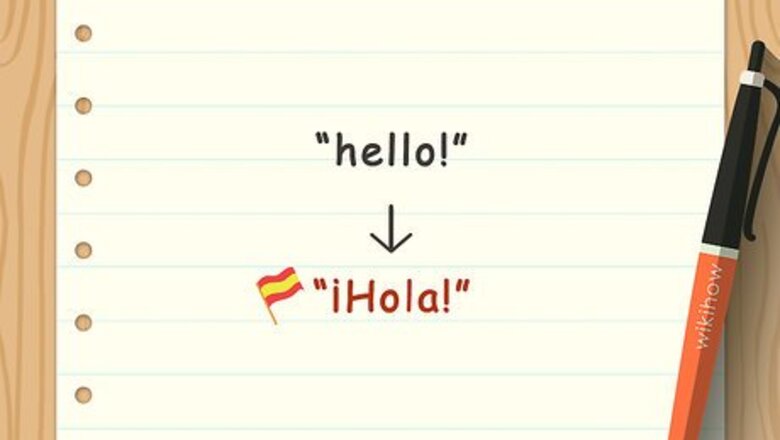
views
X
Research source
Learning Basic Greetings

Start with "¡Hola!" This is the basic greeting in Spanish, and can be used to greet any person in any situation. Latin American culture in particular can be quite formal, so when in doubt, this is the best way to greet someone. If you encounter a group of people, plan on saying hola to each of them individually. This gesture may not be necessary everywhere, but it will be seen as a sign of respect regardless.

Move to more casual ways of saying "hello." Just as in English, it's common for Spanish speakers to use different greetings when talking to friends or acquaintances, or when greeting one another in a more casual atmosphere. "¿Qué pasa?" (KAY PAH-sah) means "What's happening?" "¿Qué tal?" (kay tahl) means "What's up?" "¿Qué haces?" (kay ah-says) means "What are you doing?" or "What are you up to?"

Use "¿Cómo estás?" (KOH-moh ess-TAHS) as a greeting. Just as in English, Spanish speakers often skip the "hello" and move straight to "How are you?" as a greeting. You'll change the form of the verb estar depending on who you're greeting. Say "¿Cómo estás?" when speaking informally, to someone your age or younger, or someone familiar. If you're speaking formally, to someone older than you or in a position of authority, you would say "¿Cómo está?" You can also say "¿Cómo está usted?" When in doubt, address the person formally and give them the opportunity to tell you that it's not necessary. When speaking to a group of people, say "¿Cómo están?" to address everyone.

Switch up your greeting when answering the phone. In most places, if you answer the phone by saying "¿Hola?" you'll be perfectly well understood. But most Spanish speakers answer the phone by saying "¿Aló?" In South America, you also might hear the phone answered "¿Sí?" This is especially common in business contexts. Spaniards typically answer the phone "¿Dígame?" or the shortened form "¿Díga?" This also means "hello," but is only going to be used on the phone. If you're the one making the phone call, it's polite to respond to the phone greeting with a greeting based on the time of day. For example, if you're placing the call in the morning, you might respond "¡Buenos días!" (boo-AY-nohs DEE-ahs), or "Good morning!"

Respond to "¿Cómo estás?" with "Bien, gracias" (BEE-ehn, grah-SEE-ahs). This basic response means "I'm well, thanks." Just as in English, Spanish speakers typically will say that they are doing well in response to a greeting, even if they're not. You also might respond "Más o menos," which means "okay" or "fine." It's a little more mellow than "Bien, gracias."

Alter your response depending on the greeting used. Sometimes, even in English, you find yourself on autopilot. Someone says "What's up?" and you respond "Fine, thanks!" Altering your response keeps you from making this same mistake in Spanish. For example, if someone says to you "¿Qué tal?" ("what's up?"), you might respond "Nada" (nah-dah), meaning "nothing."
Greeting People by Time of Day

Say "¡Buenos días!" (boo-AY-nohs DEE-ahs) in the morning. While this phrase literally means "Good days!" (interpreted as "good day"), it is typically used to mean "Good morning!" Generally speaking, you can use this greeting anytime before noon. Typically Spanish greetings based on the time of day are plural. You may occasionally hear "buen día," ("good day"), but "buenos días" (good days) is far more common.

Use "¡Buenas tardes!" (boo-AY-nahs TAHR-days) in the afternoon. If it's after 1 p.m. or so, you can use this afternoon greeting instead of "¡Hola!" to say "Good afternoon!" In Latin America, you typically wouldn't use this greeting after the sun goes down, but in Spain you may hear it used well into the evening.

Say "¡Buenas noches!" (boo-AY-nahs NOH-chays) in the evening. This phrase means "Good night," and is used as both a greeting and a way to say goodbye. When used as a greeting, it would more accurately be translated as "Good evening!" Typically "¡Buenas noches!" is considered a more formal greeting, so be mindful of the context. Use it more frequently with strangers, especially those who are older than you.

Try "¡Muy buenos!" (moo-ee boo-AY-nohs) at any time of day. "¡Muy buenos!" is a shortened version of all of the greetings based on the time of day. If it's around noon, or late afternoon, and you're unsure which greeting would be appropriate, you might want to use this one.
Using Local Slang

Listen to native speakers. When you first enter a Spanish-speaking country or neighborhood, take a few minutes to listen and absorb the conversations around you. This will allow you to pick up some casual ways locals greet each other. You also may be able to pick up some slang by watching Spanish-language television, or listening to Spanish-language music, especially pop music.

Use "¿Qué onda?" (kay OHN-dah) in Mexico. The literal translation of this phrase in English ("what wave?") doesn't make a lot of sense. But the phrase is commonly used as a casual and informal greeting, generally meaning "What's up?" Watch your tone, as this phrase also can be interpreted as something similar to "You got a problem?" Another common way to say "hi" in Mexico is "Quiubole" or "Q'bole" (pronounced KYOO boh-leh). "¿Qué onda?" is also common in many other parts of Latin America. If you hear someone else saying it, feel free to use it.

Try "¿Qué más?" (kay mahs) in Colombia. This phrase literally means "What else?" but is used in Colombia and some other parts of Latin America as a greeting meaning, roughly, "What's up?"

Use "¿Qué hay?" (kay aye) or "¿Qué tal?" (kay tahl) in Spain. These two phrases are used as colloquial greetings in Spain, similar to how you would say "Hey!" or "What's up?" to a friend in English.

Learn colloquial responses to Spanish greetings. Just as you can greet someone using a slang or colloquial phrase, you also can respond to their greeting in kind. These are phrases you'll likely use with friends or acquaintances, or people around your age. One common response is "¡No me quejo!" (noh may KAY-hoh), or "Can't complain!" You also might respond "Es lo que hay" (ess loh kay aye), which means "It is what it is." This can be a clever response if you're asked "¿Qué es la que hay?" (kay ess lah key aye), which is a common slang greeting in Puerto Rico.




















Comments
0 comment